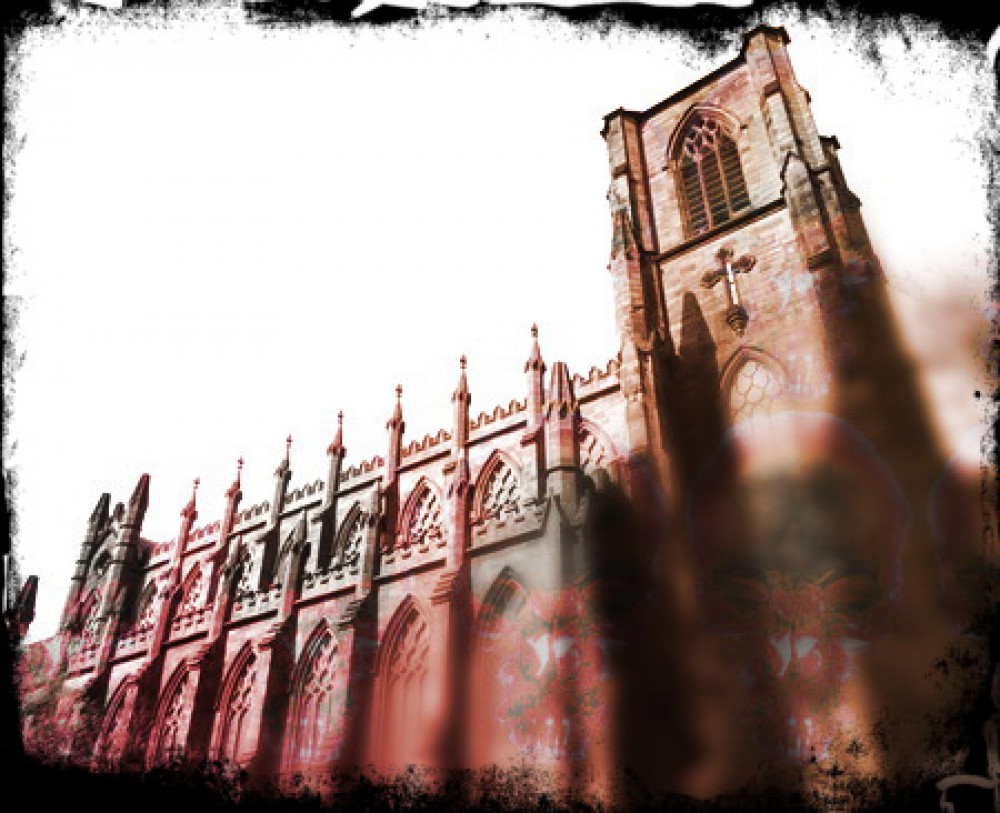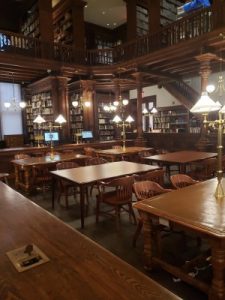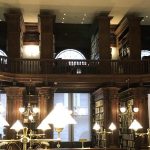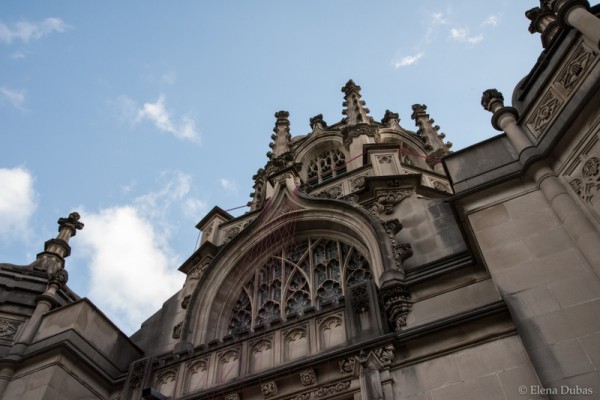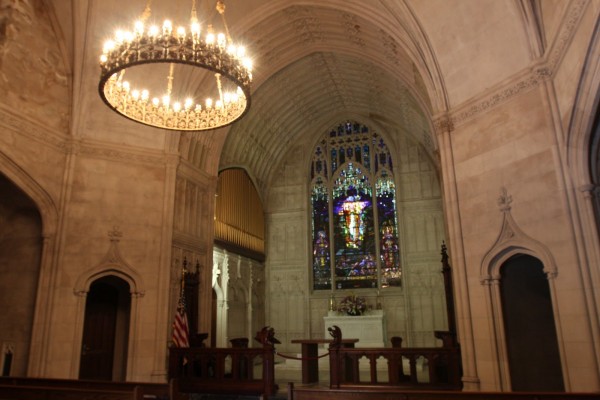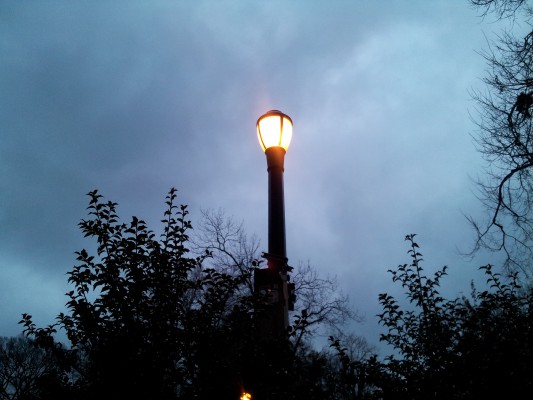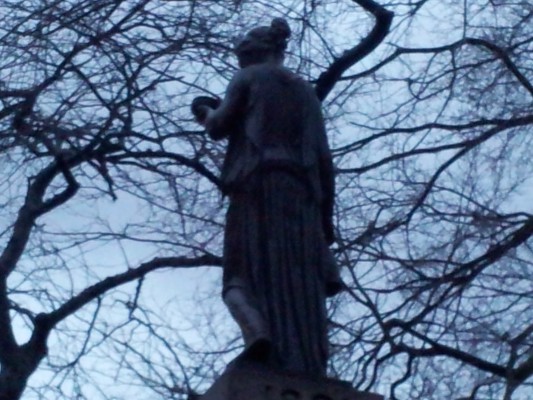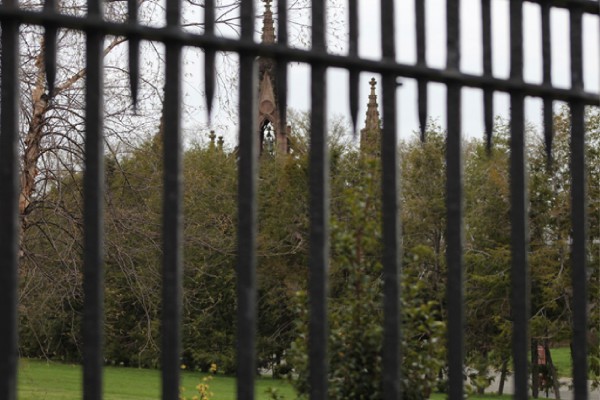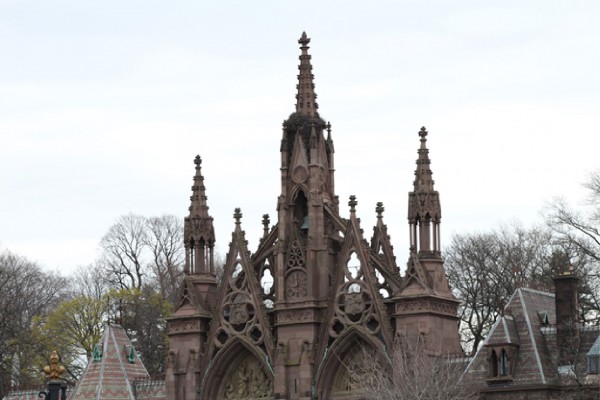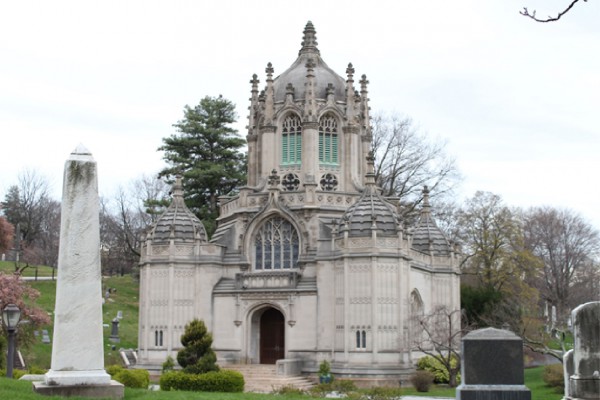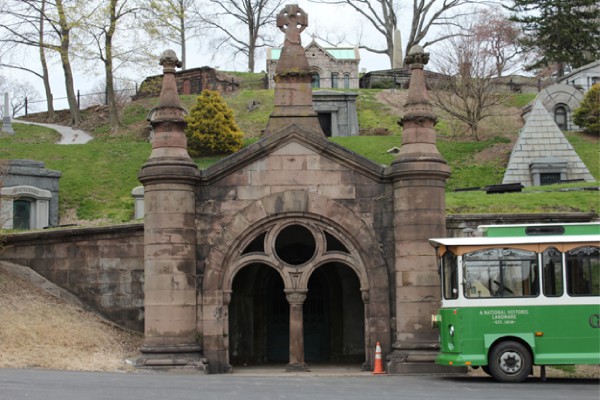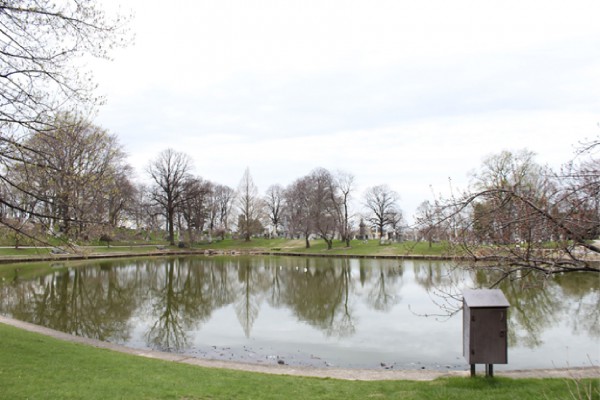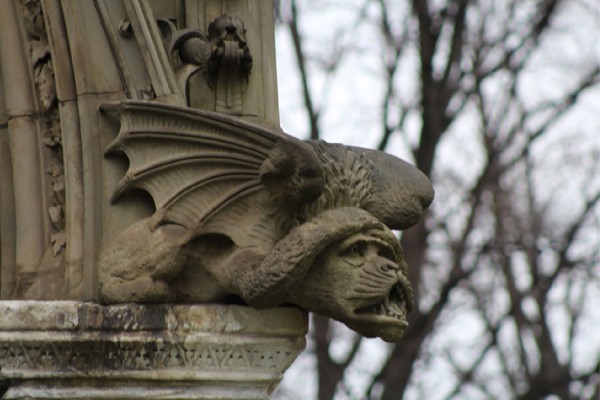The statue in The Castle of Otranto brings about the death of Conrad and marks his place of burial much like the statue in greenwood marks the burial of the mayor of the City of Brooklyn. Conrad was “buried” underneath the helmet that fell on him. “Shocked with these lamentable sounds, and dreading he knew not what, he advanced hastily, – but what a sight for a father’s eyes! – he beheld his child dashed to pieces, and almost buried under an enormous helmet, a hundred times more large than any casque ever made for a human being and shaded with a proportion-able quantity of black feathers.” (Walpole 5) This passage is referencing when Conrad was slain by the falling helmet that essentially buried him beneath. This is very similar to how the mayor of the City of Brooklyn and his wife are buried beneath the statue. Both the statue and the helmet in the text mark their final resting places. Its worthy to note as well that both the angel statue and the helmet are representative of “protection”. Angels are seen as protectors and bring others security. Suits of armor and helmets also provide one with protection and security.
Monthly Archives: April 2019
Brooklyn Historical Society
Jeremy Diaz & Brianna Thomas
Atmospheric Concept: Decaying Grandeur and Idyllic
Architectural Concept: Medieval, Castle, and Library
The outside of the building was red bricked with an arched entrance way with intricate designs carved into the stone above the arch way. On the inside on the first floor, the floor had patterned tiling and the bottom half of the wall was covered in decorated wood with one wooden bench. The top half of the wall was white and covered in either portraits of various historical figures that lived in Brooklyn or landscape paintings. There was an old wooden staircase that would groan under even the lightest footstep. This staircase lead directly into the library whose doors were also arched with decorated wood. The library was grand. The space had gothic elements stained glass windows, high vaulted ceiling, Corinthian style columns that surrounded the base floor, bookshelves twice our size and paintings whose eyes just followed you around the room. Every shelf had books that were new and old but all books were written about Brooklyn or written by someone who lived in Brooklyn.
The sublime in gothic literature is when an object, be it place, item and/or person elicits awe in the majesty of it’s being but also the feeling of fear and terror. It is also used as a sign to eldritch behaviour in characters that at first would otherwise seem normal.“Gothic literature is a combination of horror fiction and Romantic thought; Romantic thought encompasses awe toward nature. Essentially, Romanticism is a reaction against the Enlightenment, a time that revolutionized scientific thought, and emphasizes emotional response and intuition over clinical knowledge. Romantic literature elicits personal pleasure from natural beauty, and Gothic fiction takes this aesthetic reaction and subverts it by creating delight and confusion from terror. This use of terror is called the sublime, which is an important tool in these narratives.” – Emily Deibler. The Brooklyn Historical Society is a place that fits the definition of the sublime. The sublime is a place of such excellence, grandeur, or beauty as to inspire great admiration or awe but also terrifying in the fact that it’s silence is haunting and the paintings seem to follow you around as though they were alive.
The gothic novel that shares the same theoretical concept of the sublime as the Brooklyn Historical Society is Horace Walpole’s The Castle of Otranto. Both of the buildings with a magnificent and imposing appearance for such odd buildings. For example, their portraits and paintings inside. In The Castle of Otranto there is a painting of Alfonso the Great that stares down on the conversation that Manfred and Isabella are having and when Isabella flees the painting leaps from the wall to lead Manfred through his castle.”
At that instant the portrait of his grandfather, which hung over the bench where they had been sitting, uttered a deep sigh, and heaved its breast. Isabella, whose back was turned to the picture, saw not the motion, nor knew whence the sound came, but started, and said— “Hark, my Lord! What sound was that?” and at the same time made towards the door. Manfred, distracted between the flight of Isabella, who had now reached the stairs, and yet unable to keep his eyes from the picture, which began to move, had, however, advanced some steps after her, still looking backwards on the portrait, when he saw it quit its panel, and descend on the floor with a grave and melancholy air. The painting in the Historical Society might look haunting and weird at first but once you take a step back and take a moment to recognizes it is splendid piece of work and a wondrous part of the history of Brooklyn.
- Brooklyn History Books
- Library Entrace
- Brooklyn Historic Cards
- Brroklyn Locator
- Historic Paintings
Greenwood Cemetery Chapel
History
The chapel was designed in 1911, 73 years after the establishment of the cemetery. It was built by Warren and Wetmore, the same architecture firm that produced Grand Central Station. The style is neo-gothic revival. Neogothicism was an architectural movement that took place in the 18th century. With the resurgence of Catholicism in Western Europe at this time, architects wanted to emulate Catholic designs. This contrasted with tamer neoclassical architecture.
Gothic Architecture is known for being very elaborate. It was popular during the renaissance period and was symptomatic of a time when people relinquished their hope for the mortal world. Art was pious in purpose and ostentatious displays of wealth even in death were directed at the divine. This religious materialism is ubiquitous in many Catholic art styles.
In 1885, architect, Richard Upton, planned for a “Gothic Revival style central-plan mortuary chapel” but in 1863 the cemetery voted against it. Currently the Steinway Mausoleum stands where it was originally supposed to be built. However in the early 1900’s they proceeded with the plan and built it on Arbor Water. They preferred the new site because of it’s proximity to the main entrance and because it could be constructed without altering the landscape.
Common gothic architectural features include: flying buttresses, finials, pointed arches, nave vaulting, spires, arches, stained glass windows. All these elements are on display in the Greenwood Cemetery Chapel. Horace Walpole, the author of “The Castle of Otranto” is widely credited for popularizing the neogothic revival movement when he constructed Strawberry Hill House in Twickenham, London. It is widely known that the man had a small obsession with everything gothic. This obsession pours out from his prose.
Many traditional structures served as inspiration for more modern architects, as is evident here with the greenwood cemetery chapel. In actuality, the chapel is based on the Tower at Christ Church Cathedral in Oxford, England and not Neuschwanstein Castle as was the inspiration for the Disney Castle.
Appearance
About fifty yards from the cemetery’s 25th street entrance, The Greenwood Cemetery Chapel sits nestled claustrophobically in a cul-de-sac of gravesites. Morning comes and the mist creeps up from the small pond that lies to the South. The shroud obscures the chapel’s nakedness; the ostentatious limestone facade normally left exposed by the small trees and shrubbery. The summery scene at the bottom of the hill is inappropriately green for one surrounded by so much death.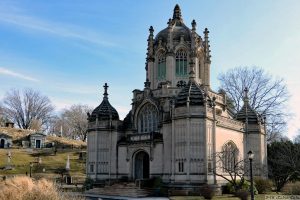
The chapel’s spires and cornices are stylistically consistent with the nearby entrance gate. Every inch of the building is heavily ornamented, even the corners are rounded out into turrets, topped by rounded cupolas. The cupolas themselves are ridged as if with the scales of a dragon, or sheets of rain on a window pane. There’s an unplaceable ugliness to it all and it mildly resembles the Disney Castle if hit with a shrink ray. Perhaps it’s the culmination of excessive domes and arches all crammed into its awkward stout frame. Given the pointed arches adorned with finials, floral moldings, spires and other such Gothic affectations, it’s hard to believe the chapel was designed by the same people responsible for Grand Central Station.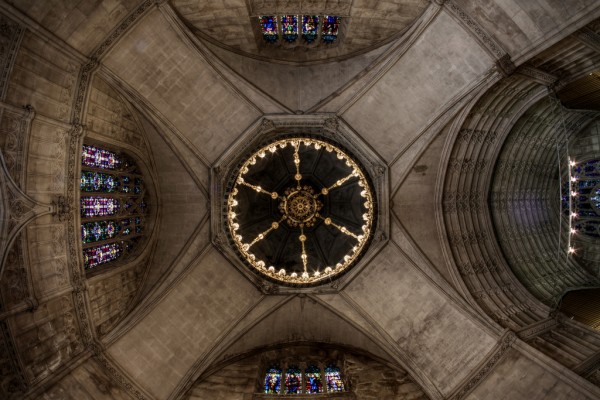
A chill runs through you upon entry, perhaps an otherworldly presence, or maybe it’s just the 24/7 air conditioning on full blast. A Roman chandelier hangs close overhead; a proverbial ring of fire. There are a few rows of pews and an altar-like stage, like that of an old courthouse. Stained glass windows take up most of the wall space, refracting dancing colors onto the floor.
There is a simplicity to the interior that can’t be seen from the outside. The likely cause of the interior’s relative sparsity is that unlike other Gothic churches, the chapel is non-denominational.
The Castle of Otranto
The chapel is reminiscent of the church of St. Nicholas in “The Castle of Otranto.” The church is a place of asylum, just as the chapel in Greenwood provides respite from the surrounding field of the dead. It is a solitary monument against the gloom. “’We must go down here,’ said Isabella. ‘Follow me; dark and dismal as it is, we cannot miss our way; it leads directly to the church of St. Nicholas. But, perhaps,’ added the Princess modestly, ‘you have no reason to leave the castle, nor have I farther occasion for your service; in a few minutes I shall be safe from Manfred’s rage—only let me know to whom I am so much obliged” (Walpole 45). In this passage, Isabella flees Manfred through the labyrinthian dungeons for the safety of the church.
The church also has a deeper significance. It serves as both physical and metaphorical salvation because the church is the one place people look to protect their souls from the horror of mortality. In the book Isabella seeks the church to preserve her physical body from Manfred’s unwanted lust and Manfred seeks Isabella to preserve his legacy. His hope is that she will bear sons and continue his family name, saving him from the metaphorical death that is promised. Manfred makes this point explicit to the friar: “Manfred, accompanied by the Friar, passed to his own apartment, where shutting the door, “I perceive, Father,” said he, “that Isabella has acquainted you with my purpose. Now hear my resolve, and obey. Reasons of state, most urgent reasons, my own and the safety of my people, demand that I should have a son” (Walpole 99). To Christians, this church represents the same hope that Isabella represents to Manfred and that she represents to him.
The greenwood chapel is similar because it also stands alone amidst tombs and mausoleums and protrudes with its beauty, despite its intimidating grandeur. The window dividing its dome is circular. Like an eye that god can peek through when he shines his spotlight on you. The church is the building the dead must pass through to leave this world, the promise that death isn’t the end.

Works Cited
Landmarks Preservation Commission. “GREEN-WOOD CEMETERY CHAPEL.” GREEN-WOOD CEMETERY CHAPEL, 2016, s-media.nyc.gov/agencies/lpc/lp/1233.pdf.
Walpole, Horace. The Castle of Otranto, a Gothic Story. Translated by William Marshal, Gent. from the Original Italian of Onuphrio Muralto .. Printed for Wenman and Hodgson, 1793.
Gothic Texts
The Haunting of Hill House
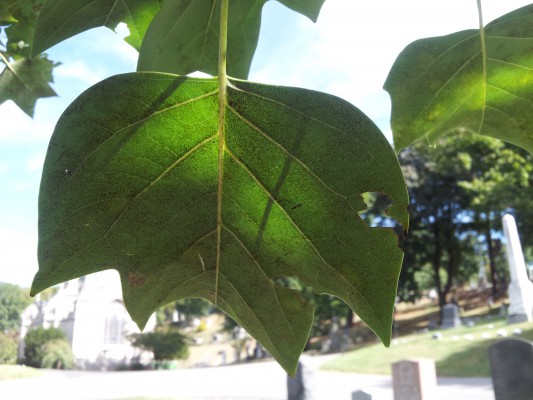
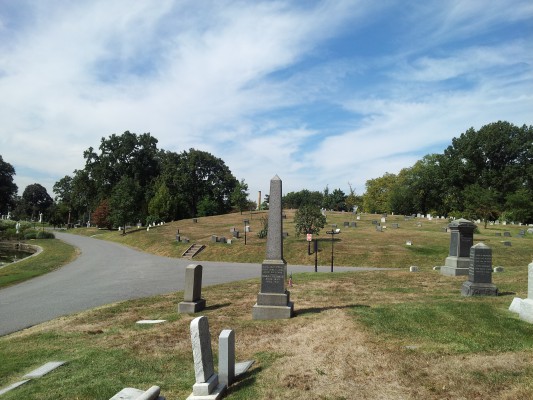
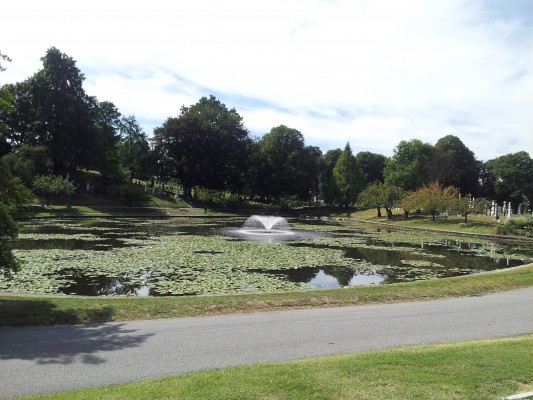
The cemetery does have a very beautiful side to it; the vegetation, the magnificent tombstones and statues, even the architecture can take your eyes away from your phone! But even walking around the cemetery, you being to notice this uncanny feeling which the cemetery emits. The outskirts of the park are fenced off to keep unwanted visitors out. However, as time has passed by, plants have consumed the gates, turning them into immense walls of leaves and shrubs, concealing the inside of the cemetery and what lurks within. This brings an uncanny feeling about you, much like Jonathan Harker felt in Bram Stoker’s novel “Sometimes, as the road was cut through the pine woods that seemed in the darkness to be closing down upon us…which…produced a peculiarly weird and solemn effect.” He halso says “There are many trees on it, which make it in places gloomy.”
As you walk into the cemetery, there is nothing but a beautiful and magnificent entrance, which looks something out of the medieval era. With tall, pointed structures towering high in the sky, and circular arch entrances, one can’t help but feel as though they are walking into a castle. However, as you get closer, you begin to notice the pointed edges, the dramatic and dark curves and designs, and the gothic statues on this colossal monument. As you walk further into the cemetery, no matter which path you take, you will come across a huge gothic building, filled with gothic architecture. You cannot help but describe the structure as beautiful but eerie. We see similarities within Stoker’s novel, when Harker first arrives to Dracula’s castle, when Harker says “…If I had been fully awake I must have noticed the approach to such a remarkable place. In the gloom the courtyard looked of considerable size, and as several dark ways led from it under great round arches it perhaps seemed bigger than it really is.” Dracula even mentions the appearance of the house, saying “The house is very large and of all periods back…to medieval times…and is close to an old chapel or church.” As you approach the entrance of the cemetery, just as Harker arrived to Dracula’s castle, the first thing you notice is the magnificence of the structure in front of you, with its medieval appearance.
As you continue through the cemetery, you will learn that it is easy to get lost within. There are countless pathways and roads, all leading in different directions. This signifies the uncanny, as you take your first steps down an unknown path, you feel both curiosity and interest, but also fear of getting lost, especially in a cemetery for crying out loud! Dracula actually tells Harker after Harker comes into the castle “You may go anywhere you wish in the castle, except where the doors are locked, where of course you will not wish to go.” Much like Dracula’s castle, you are free to explore each pathway and road in the cemetery. However, if you look carefully, there are passages underneath the cemetery itself, where one is not allowed to enter, leaving one to only wonder what is beyond the doors in front of them.
If you walk deep enough into the cemetery, you will come across a large pond, where you can sit on benches and enjoy the scene in front of you. However, as day becomes night, the pond becomes an eerie graveyard for those underneath it. You cannot help but picture zombies rising from the depths of the water, coming towards you to eat you whole (where my Walking Dead fans at?). The silence is deafening as the animals call in for the night; you cannot see what lurks beneath, until your nerves are tested by mysterious sounds emerging from the pond itself. Is it a zombie? A monster? A sea creature? It is up to you to decide if you stay to find out what it was that made the noise, or run like hell! Harker actually talks about a lake on Dracula’s property, when he says “…which make it in places gloomy…there is a deep, dark-looking pond or small lake.”
Similar to Bram Stoker’s novel “Dracula”, upon visiting GreenWood cemetery, one cannot help but feel as though they are walking into Dracula’s castle of death. Dracula himself signifies death, which can be seen at this location no matter which direction you turn your head. As you arrive at the cemetery, you can see the vegetation hiding what lurks inside, much like the forest which Harker had to travel through to get to the castle. You can even picture yourself as Jonathan Harker himself, arriving at Dracula’s castle and admiring the beautiful medieval gothic architecture before you. As you enter, you are confronted by countless passageways and roads, much like Harker as he travelled through the halls of the castle. However, some of the rooms in the castle were locked and forbidden to enter, much like the doors leading to the underground passageways in the cemetery. The dark and mysterious pond holds secrets within its depths, letting the visitor’s imagination take hold of them. Much like “Dracula”, GreenWood cemetery holds its secrets, and if you are not careful, you may end up overstaying your welcoming, losing yourself in the mysteries of GreenWood.
The Castle of Otranto
The statue in The Castle of Otranto brings about the death of Conrad and marks his place of burial much like the statue in Greenwood marks the burial of the mayor of the City of Brooklyn. Conrad was “buried” underneath the helmet that fell on him. “Shocked with these lamentable sounds, and dreading he knew not what, he advanced hastily, – but what a sight for a father’s eyes! – he beheld his child dashed to pieces, and almost buried under an enormous helmet, a hundred times more large than any casque ever made for a human being and shaded with a proportion-able quantity of black feathers.” (Walpole 5) This passage is referencing when Conrad was slain by the falling helmet that essentially buried him beneath. This is very similar to how the mayor of the City of Brooklyn and his wife are buried beneath the statue. Both the statue and the helmet in the text mark their final resting places. Its worthy to note as well that both the angel statue and the helmet are representative of “protection”. Angels are seen as protectors and bring others security. Suits of armor and helmets also provide one with protection and security.
History
History
Established in 1838, Greenwood cemetery was designed by architect David Bates Douglass as a response to the rotting corpse problem in Manhattan and served as a resting place for many New Yorkers.
The gates were designed by an English architect Richard Upjohn in “gothic revival style” which was also the same style that Strawberry Hill(Castle of Otranto) was based upon. The gothic revival style contains medieval designs which means that the castle of Castle of Otranto was based on the same style as the gates of Greenwood Cemetery.
The entrance of the cemetery was build in 1861 to 1865 which is during the Civil War. That is no coincidence of course as it is a resting place for many Civil War veterans since the burials for the veterans were free.
Biblical figures play an important role in the cemetery as well as it tells the story of Jesus’ resurrection. The gates symbolize the miracle of Christ. Just like how the gates depict the light of Christ, there is a dark side to the cemetery as well.
Another one of the many focal points of this cemetery that caught my eye was the Angel of death that is located above Charles Schieren’s grave.he was the mayor of Brooklyn so it’s not like he was some sort of devils worshiper. The Azrael figure shouldn’t be hard to spot even though it’s is concealed in a hooded cloak, her face deeply recessed and only visible to one willing to kneel below the overall 40-inch height of the piece on its granite plinth. Her arms are stretched out to each side with fingertips touching large closed books, symbolizing the “fullness of their years.” The sculptor, who was a personal friend of the Schieren family, was inspired to create a unique work, very different from cemetery memorials of the period. It is quite the eerie sight one because it is unusual I mean not for a cemetery but who puts the grim reaper on there grave. The statue shows great oxidation because it has not been kept or protected which gives it character. It is to guard them in the afterlife? The cemetery itself is very quiet and for Nyc finding a quiet place isn’t usually an easy task. You can hear the wind howling and its almost like you can hear the voices of people which is a bone-chilling experience if you’re into that. The statue itself isn’t very distinct and at first, when I saw it I didn’t really know what it was. It wasn’t until I looked under the hood that I saw a face and was kinda fascinated. I would love to visit it in the evening with the sun setting I’d recommend it at that hour if of course, you can get in past closing time. But its risky and I don’t advise it but even In the day time it is quite the place to visit.
The Angel above Schierens grave is both sublime and queer in that there is a beauty in death. In Gothic storytelling, the word sublime refers to the natural beauty that which surrounds us. This can sometimes cause confusion or intrigue, for example, the fact that we no longer have to worry about any worldly desires. Any fear, hate, pain, sorrow, or grief. On the flip side, there also is not any curiosity, love, pleasure, happiness, or joy to look forward to either. So some people might, in fact, look forward to the bittersweet release of death.
This can then also be seen as sublime since death is a natural occurrence that most people fear while others wish for it. On the other hand, queer, in the normal sense of the word, is when something is not what the average person would consider normal. On the contrary to the sublime nature of death where many fear death, the ones who actively seek it would be considered queer. Knowing this, it can be seen as queer because it is not normal for someone to want and actually get a reaper as their gravestone as most people acknowledge the angel of death as a being they don’t want to meet. So seeing this, it can be seen as even an altar or shrine to the angel. The queerest thing though would have to be the face of Azreal. It can only be seen properly when laying on the grave. Most people would not want to do this feat but never fear, it was done for you reader!
